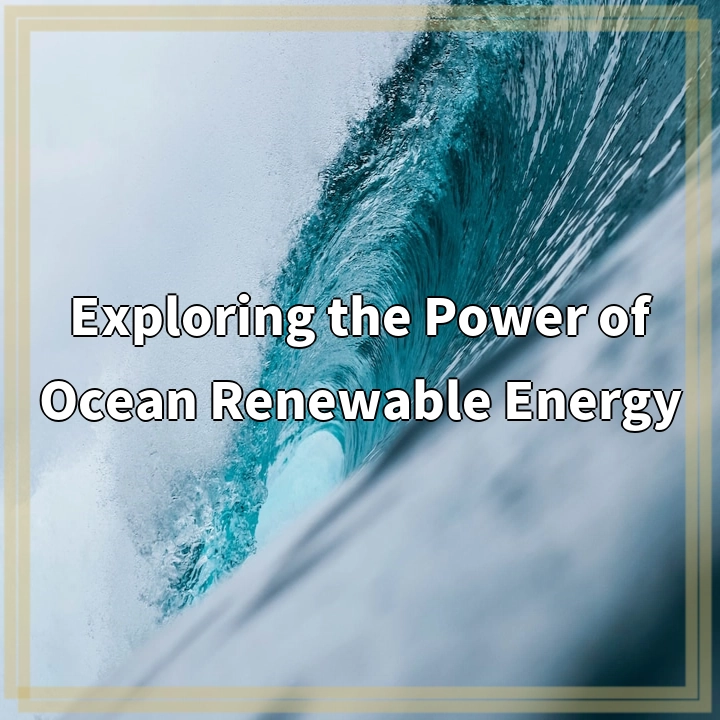
What is Ocean Renewable Energy?
Ocean renewable energy refers to the harnessing of energy from the ocean’s vast resources, including waves, tides, currents, and temperature gradients. It is a form of renewable energy that holds tremendous potential for providing sustainable and clean power.
Exploring the Power of Ocean Renewable Energy
Ocean renewable energy has gained increasing attention as a reliable and sustainable alternative to traditional fossil fuel-based energy sources. It offers several advantages, such as being abundant, widely distributed, and more predictable than other renewable energy sources like wind or solar.
Harnessing the power of the ocean can significantly contribute to reducing greenhouse gas emissions and mitigating climate change. Furthermore, it can create new economic opportunities, promote job growth, and enhance energy security.
The Real-World Problems of Ocean Renewable Energy
While ocean renewable energy holds great promise, there are several challenges and real-world problems associated with its implementation and widespread adoption.
1. High Initial Costs
One of the major obstacles to the expansion of ocean renewable energy is the high upfront costs involved in developing and deploying the necessary technologies. Setting up offshore infrastructure, such as wave energy converters or tidal turbines, requires significant investment, making it financially challenging for many countries or companies to pursue.
2. Technical and Design Limitations
Ocean environments are harsh and continually changing, presenting unique technical and design challenges for ocean renewable energy systems. Building and maintaining infrastructure that can withstand strong waves, corrosive saltwater, and extreme weather conditions can be complex and costly. It requires careful engineering and continuous innovation to improve the efficiency, reliability, and durability of devices used in ocean energy generation.
3. Environmental Impact and Marine Life Concerns
The installation and operation of ocean renewable energy systems have the potential to impact marine ecosystems and wildlife. For example, the presence of turbines or structures can create barriers for fish migration or affect habitat quality. It is essential to conduct thorough environmental assessments and consider marine life preservation during the planning and deployment stages to minimize these impacts.
4. Permitting and Regulatory Hurdles
Navigating the complex web of regulations and obtaining necessary permits for installing and operating ocean renewable energy projects can be time-consuming and challenging. Balancing the need for clean energy development with environmental protection and stakeholder considerations requires robust regulatory frameworks and effective collaboration between government agencies, industry stakeholders, and local communities.
5. Intermittency and Grid Integration
Ocean energy sources, such as waves and tides, have inherent variability, leading to intermittency in power generation. Integrating this intermittent energy into existing electricity grids and ensuring a stable and reliable supply can be a technical and logistical challenge. Energy storage technologies and grid infrastructure upgrades are crucial in addressing the intermittency issue and effectively utilizing ocean renewable energy sources.
Conclusion
Exploring and harnessing the power of ocean renewable energy offers significant potential for clean, sustainable power generation. However, addressing the real-world problems associated with its implementation requires a holistic approach involving technological advancements, policy support, and stakeholder engagement. By overcoming these challenges, ocean renewable energy can play a vital role in transitioning to a low-carbon future and mitigating the impacts of climate change.

Solutions for Ocean Renewable Energy
1. Cost Reduction and Financial Support
To overcome the high initial costs of ocean renewable energy infrastructure, governments and funding organizations can provide financial incentives, grants, and subsidies to support the development and deployment of ocean energy projects. This can encourage private sector investment and help drive down costs over time.
2. Technology Advancements and Research
Continued research and development efforts are essential to improve the efficiency and reliability of ocean energy devices. Investing in innovative technologies and optimizing designs can help overcome technical and design limitations, making ocean renewable energy systems more robust and cost-effective.
3. Environmental Impact Assessments and Mitigation Strategies
Conducting thorough environmental impact assessments before implementing ocean energy projects is crucial. This includes assessing potential impacts on marine life and habitats and developing mitigation strategies to minimize harm. Collaboration with marine biologists, environmental organizations, and local communities can ensure responsible and sustainable deployment of ocean renewable energy.
4. Streamlined Permitting Processes and Regulatory Frameworks
Governments can work on streamlining and simplifying the permitting and regulatory processes associated with ocean energy projects. This can include establishing clear guidelines, promoting stakeholder engagement, and ensuring transparent decision-making processes. Collaboration between various stakeholders can help balance environmental concerns with the need for clean energy development.
5. Integration with Smart Grid Systems and Energy Storage
To address intermittency issues, it is crucial to invest in smart grid systems that can efficiently distribute and manage energy from ocean renewable sources. Additionally, the development of energy storage technologies, such as batteries, can help store excess energy during peak generation periods for later use, ensuring a stable and reliable power supply.
Conclusion
By implementing these solutions, we can overcome the challenges associated with ocean renewable energy and unlock its vast potential as a clean and sustainable power source. Governments, industries, and communities must collaborate in fostering innovation, providing financial support, and improving regulatory frameworks to accelerate the deployment of ocean energy systems. Doing so will contribute to a greener future and help mitigate the impacts of climate change.















